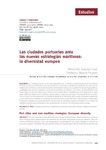Mostrar el registro sencillo del ítem
Las ciudades portuarias ante las nuevas estrategias marítimas: la diversidad europea
| dc.contributor.author | González-Laxe, Fernando | |
| dc.contributor.author | Martín Palmero, Federico | |
| dc.date.accessioned | 2020-11-09T12:36:30Z | |
| dc.date.available | 2020-11-09T12:36:30Z | |
| dc.date.issued | 2020 | |
| dc.identifier.citation | González-Laxe, F., & Martín-Palmero, F. (2020). Las ciudades portuarias ante las nuevas estrategias marítimas: la diversidad europea. Ciudad Y Territorio Estudios Territoriales (CyTET), 493-506. https://doi.org/10.37230/CyTET.2020.205.04 | es_ES |
| dc.identifier.issn | 1133-4762 | |
| dc.identifier.uri | http://hdl.handle.net/2183/26662 | |
| dc.description.abstract | [Resumen] Las ciudades-puerto se han visto afectadas por las fuertes transformaciones de las últimas décadas y han ido modificando sus características y funciones a medida que avanzan los procesos de integración económica. Están estrechamente determinadas tanto por sus propias limitaciones geográficas, morfológicas y vínculos espaciales como por los mercados económicos. Por tanto, se sitúan frente a una doble lógica: la de atracción y la de rechazo de los flujos físicos. Dualidad que se fundamenta en gran parte sobre los trabajos de la interface puerto-ciudad y sobre las opciones de re-desarrollo de los espa-cios en crisis. En esta aportación se tratará de discernir la formación de los nudos portuarios siguiendo la evolución de las ciudades, se mostrará la evolución de la disociación física entre puerto y ciudad para, finalmente, subrayar las particularidades de una serie de ciudades y puertos europeos en sus tareas de redefinir sus funciones portuarias y sus orientaciones en torno a las relaciones puerto-ciudad. | es_ES |
| dc.description.abstract | [Abstract] The port cities have been affected by the strong transformations of the last decades and have been changing their characteristics and functions as economic integration processes advance. They are closely determined both by their own geographical, morphological and spatial linkages as well as by economic markets. Therefore, they are placed in front of a double logic: the one of attraction and the one of rejection of the physical flows. Duality that is largely based on the works of the port-city interface and on the options for redevelopment of spaces in crisis. In this contribution will try to discern the formation of port knots following the evolution of cities, will show the evolution of physical dissociation between port and city to finally highlight the particularities of a number of European cities and ports in their tasks to redefine its port functions and its orientations around port-city relation. | es_ES |
| dc.language.iso | spa | es_ES |
| dc.publisher | Ministerio de Fomento | es_ES |
| dc.relation.uri | https://doi.org/10.37230/CyTET.2020.205.04 | es_ES |
| dc.rights | Atribución-NoComercial 4.0 Internacional (CC BY-NC 4.0) | es_ES |
| dc.rights.uri | https://creativecommons.org/licenses/by-nc/4.0/deed.es | * |
| dc.subject | Ciudades portuarias | es_ES |
| dc.subject | Competencia portuaria | es_ES |
| dc.subject | Desarrollo urbano | es_ES |
| dc.subject | Integración puerto-ciudad | es_ES |
| dc.subject | Port cities | es_ES |
| dc.subject | Port competitiveness | es_ES |
| dc.subject | Urban development | es_ES |
| dc.subject | Integration city-port. | es_ES |
| dc.title | Las ciudades portuarias ante las nuevas estrategias marítimas: la diversidad europea | es_ES |
| dc.type | info:eu-repo/semantics/article | es_ES |
| dc.rights.access | info:eu-repo/semantics/openAccess | es_ES |
| UDC.journalTitle | Ciudad y territorio. Estudios territoriales | es_ES |
| UDC.volume | 52 | es_ES |
| UDC.issue | 205 | es_ES |
| UDC.startPage | 493 | es_ES |
| UDC.endPage | 506 | es_ES |
| dc.identifier.doi | 10.37230/CyTET.2020.205.04 |






